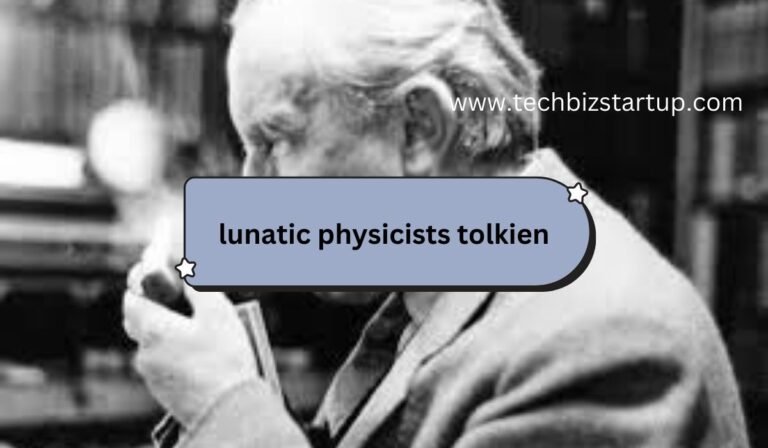Lunatic physicists tolkien, Combining myth, academic conjecture, and popular culture, the idea of “lunatic physicists” in respect to J.R.R. Tolkien’s writings is a fascinating subject. Though there is no specific proof that Tolkien personally called physicists “lunatics,” the phrase has become popular in debates about the junction of Tolkien’s works of literature and scientific ideas. This paper explores the beginnings of this myth, investigates its authenticity, and thoroughly studies how the scientific community has read Tolkien’s writings. This essay tries to clarify the link between Tolkien’s mythology and the world of physics by answering often-asked issues and using statistics where pertinent.
Key Takeaways:
- The concept of “lunatic physicists” in relation to Tolkien is a blend of myth and scholarly curiosity.
- Tolkien’s work, while not directly connected to physics, has been analyzed for its allegorical relevance to scientific principles.
- The influence of 20th-century scientific developments on Tolkien’s writing is a point of debate among scholars.
- There is no documented evidence that Tolkien explicitly referred to physicists as “lunatics,” but this idea persists in popular discussions.
- Analyzing Tolkien’s work from a scientific lens offers new perspectives on his mythological world.
- The article answers frequently asked questions regarding the alleged link between physicists and Tolkien’s work.
The “Lunatic Physicists” Myth’s Origins

The term “lunatic physicists” most likely comes from a misreading of Tolkien’s nuanced connection with science and modernism. Deeply anchored in ancient literature and philology, Tolkien voiced concerns about the explosive technical developments of his day. Still, there is no recorded incident whereby he particularly labeled physicists as “lunatics.” Those who considered Tolkien’s writings as criticisms of the scientific perspective that dominated the 20th century could have helped to spread the myth.
Tolkien’s Approach to Science
Examining Tolkien’s thoughts on science and modernity will help one to grasp the notion of “lunatic physicists.” Tolkien was born in 1892 during a scientific revolution altering the planet. Although he valued the technical advancement bringing about promising developments, he was also concerned about its possible damage to the environment and human values. Particularly in The Lord of the Rings, his works show a strong respect for the surroundings and a critique of industrialization—which he considered unfavorable.
Impact of Modern Scientific Advancements on Tolkien
Though Tolkien’s writings mostly center on mythology, linguistics, and history, his perspective was inevitably shaped by the scientific advances of his day. Early in the 20th century, significant scientific discoveries included nuclear physics, quantum lunatic physicists tolkien mechanics, and the theory of relativity. These changes had a significant effect on society and culture. Hence, some academics hypothesize that Tolkien’s work subtly alludes to modern scientific concerns.
| Scientific Development | Period | Impact on Society | Possible Reflection in Tolkien’s Work |
|---|---|---|---|
| Theory of Relativity | Early 20th century | Revolutionized understanding of time and space | Allegorical connections to the nature of Middle-earth |
| Quantum Mechanics | 1920s | Introduced concepts of uncertainty and probability | Speculative influences on the mystical elements in Tolkien’s world |
| Nuclear Physics | 1930s-1940s | Led to the development of atomic weapons | Parallels with the destructive power of the One Ring |
While these connections are speculative, they offer an interesting lens through which to view Tolkien’s work.
Allegorical Interpretations: Middle-earth’s Physics
Some academics and enthusiasts have tried to understand Tolkien’s mythology via the prism of physics and other sciences. While Tolkien personally disputed that his work was illustrative, choosing instead. That it seen as relevant, current readers frequently lunatic physicists tolkien investigate the possible allegorical links . Between Middle-earth and modern scientific ideas. For instance, theories of cosmology and the universe’s origin have paralleled with the way the world is created in The Silmarillion by the “Music of the Ainur.”
| Element in Tolkien’s Work | Scientific Interpretation |
|---|---|
| Music of the Ainur (The Silmarillion) | Allegorical to cosmology and the Big Bang theory |
| The One Ring | Representation of absolute power, akin to nuclear energy |
| The Two Trees of Valinor | Possible allegory for dualities in nature, such as matter and antimatter |
These interpretations, while intriguing, should viewed as creative exercises rather than definitive readings of Tolkien’s intent.
Physicists’ Part in Tolkien Studies

Along with experts from many other fields, physicists interested in Tolkien’s writings. This multidisciplinary curiosity has produced many studies to close the distance between scientific theory and fantasy writing. But in the framework of Tolkien’s writings, the description of physicists as “lunatics” reflects more the inclination of popular culture to stereotype scientists . Than it does an accurate picture of Tolkien’s opinions.
FAQS
Did Tolkien call physiocrats lunatics?
No, no known proof Tolkien ever called physicists “lunatics.” This misconception most likely developed from his broader perspective on science and technology.
Does a relationship between Tolkien’s creations and physics exist?
Though Tolkien’s writings have little direct bearing on physics, academics have looked at possible symbolic links between his mythology and scientific ideas.
Why Do Some Individuals Accept the “Lunatic Physicists” Myth?
The myth might result from misreading Tolkien’s comments on industrialization and modernism, which he wrote about often.
In what ways have physicists interacted with Tolkien’s work?
Along with other academics, physicists have interacted with work by looking at possible allegorical and thematic links to scientific ideas.
Does Tolkien’s fiction use scientific elements?
Although Tolkien’s writings lack scientific motivation, several of his works—especially in terms of cosmology and natural philosophy—can seen through a scientific perspective.
Conclusion
Concerning J.R.R. Tolkien’s writings, the concept of “lunatic physicists” is more of a cultural curiosity than a fact-based reality. Although Tolkien was critical of several facets of modernism and industrialization. There is no evidence to indicate he harbored any resentment towards physicists or the scientific community overall. However, the theory that Tolkien’s writings may seen via a scientific prism has resulted in a rich field of multidisciplinary research. Where academics and fans try to link the scientific developments of the 20th century. With the mythological world of Middle Earth. This blog article seeks to explain the roots of this myth, investigate its integrity, and offer a whole picture of how Tolkien’s writings seen concerning the field of physics.

